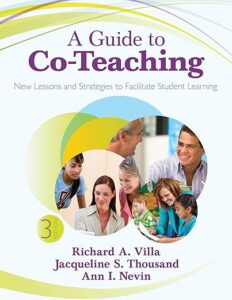
Co-Teaching Models to Use in Inclusion Settings
I have been co-teaching for over 10 years now, and I have tried many different co-teaching models with several different colleagues. Here are some of the most common co-teaching models, what they are, and why they work (and sometimes don’t).
One Teach – One Assist
What it looks like:
This is the most common co-teaching model that I see in practice in my experience. Typically you see the general education, or content teacher, standing in front of the class providing instruction as they would in their non-inclusion sections, and the special education teacher is circulating the room providing assistance to the students who need it.
Benefits:
This is a great way to make sure that students are getting on the spot help. It is also useful when you have a special education teacher who may not be as strong in the content. For example, if my school decided next year that I needed to co-teach a science class, or a different grade than I’m used to, it would take me a while to get familiar with the content and feel comfortable instructing a whole class. This model allows the special education teacher be primarily responsible for providing support to students while the general education teacher can be the content expert.
Drawbacks:
This model can be stigmatizing for the special education teacher. When I go into a classroom and all the kids know that I’m there because I’m the special education teacher, it can often lead to students being embarrassed when I help them. I work in a middle school where the students are all super self-conscious about their image. One way to avoid this is to alternate which teacher is circulating. At least 1-2 days a week my math teacher and I will switch rolls so that the students see us both equally as “their math teacher.”
Parallel Teaching
What it looks like:
Parallel teaching is when the two teachers split the class and teach the same lesson to half each. Typically the teachers would be teaching the same content and using the same methods. This is often demonstrated as two teachers in the same classroom with one teacher in the back and one in the front.
Benefits:
This is a beneficial strategy because now instead of 25 kids in a group, you have 12-13. This lends to more interaction, more ability to answer questions, and more in the moment support.
Drawbacks:
Personally, this teaching strategy does not often work for me when we try to do it in the same room. There is too much noise, and each group is distracted by the other. I have used this model and brought my group to a separate space. This worked well but I have seen conflicting information about whether or not it is still considered parallel teaching if you are using two different spaces.
Station Teaching
What it looks like:
The students are working in small groups and you have two different teacher tables, one with each teacher.
Benefits:
This allows for more time for remediation for students who are struggling. Depending on the content and the teachers, the special education teacher doesn’t always have to work with the lowest group. Sometimes the content area teachers that I co-teach with will switch and take the lower group and I’ll work with other students. This again allows for destigmatization of the special education teacher.
Drawbacks:
I have tried this method many times, it requires great classroom management and lots of practice. When you have two groups working with a teacher, that leaves the other groups with minimal supervision. You must make sure that you have a class that can handle working in a small group without an adult monitoring them closely. The adults are still in the same room but are often distracted with the group that they are working with. With some modeling and practice I have been very successful with this co-teaching model but there have been certain classes that we’ve had in the past where this wasn’t super successful.
Other, Less Popular, Teaching Models:
One Teach – One Observe
Alternative Teaching
Also, check out:
The Beginners Guide to Inclusion
FREE co-teaching checklist

Subscribe to receive a free co-teaching checklist!






2 Comments
Meredith
When you co-taught middle school was it for one class and one grade level?
I am “coteaching” 5th and 6th grade math and ELA. Additionally, I have 2 pull out classes, one for 5th and one for 6th.
I find that it doesn’t feel like co-teaching because the teacher prefers to teach the whole group.
Any suggestions?
Katie
I have been fortunate to co-teach with one eighth grade team. So I co-teach with two different teachers (ELA & Math) but they’re on the same grade level. It must be so hard to go between grades and have to know four different curriculums. Do you have a good enough relationship with the teachers that you can talk to them and ask to take a bigger role in instruction? Maybe you could find time during the month to do a little co-planning. I have had some great gen. ed. teachers that I have worked well with, but I’ve also had the co-teacher that won’t let me do any more than circulate and that stunk. I’m sorry, it can be so frustrating!
Hope this helps,
Katie